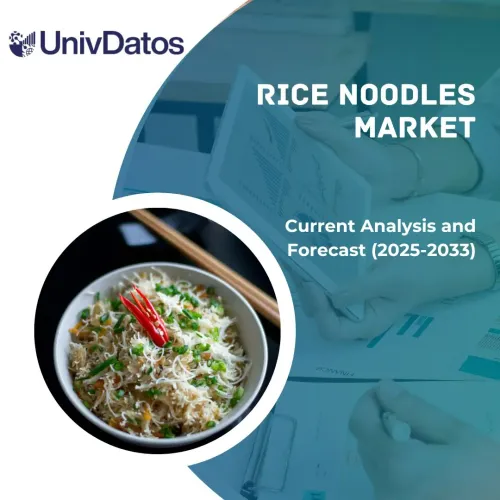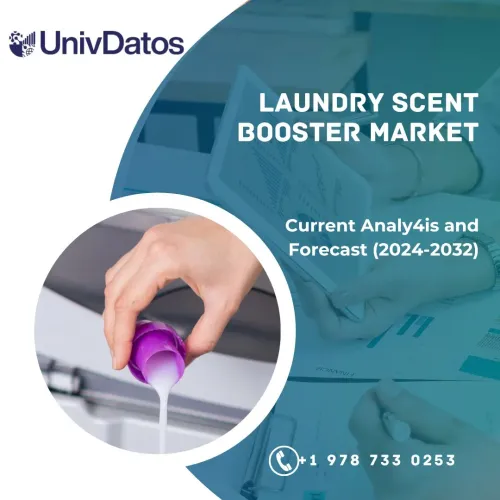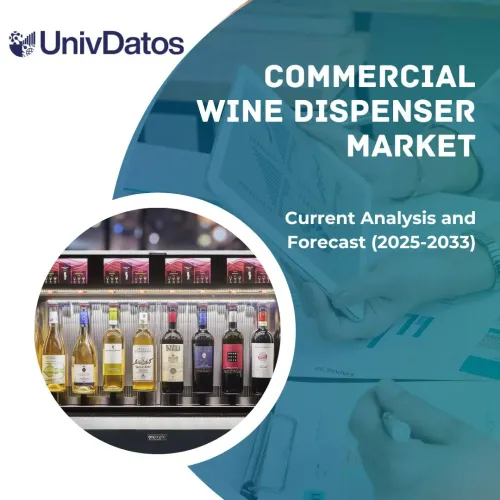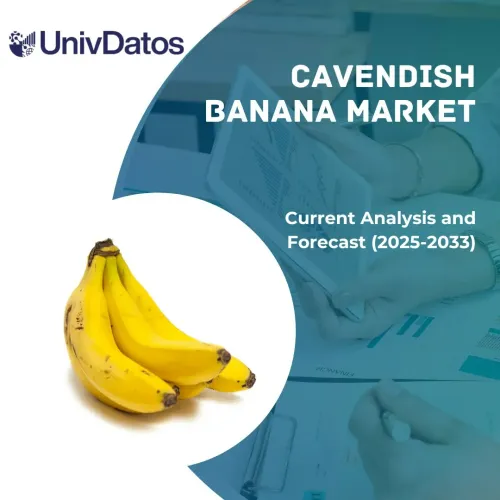- Home
- About Us
- Industry
- Services
- Reading
- Contact Us
Citrus Fiber Market: Current Analysis and Forecast (2022-2028)
Emphasis on Type (Oranges, Tangerines/ Mandarins, Grapefruit, Lemons & Lime, and Others); Nature (Organic and Conventional); Application (Food, Pharmaceuticals, and Others); and Region/Country
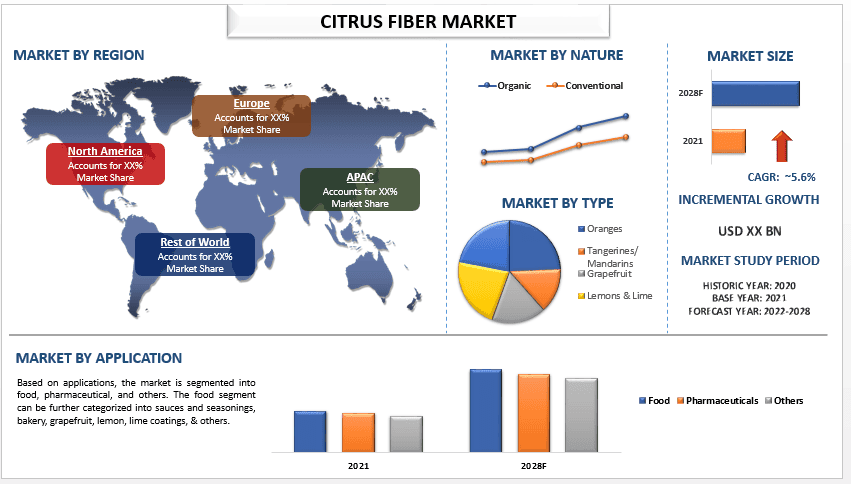
The Citrus Fiber Market was valued at more than USD 18.5 billion in 2021 and is expected to grow at a CAGR of around 5.6% from 2022-2028.
A few of the major factors contributing to the market growth are an increase in consumption of key nutrients like citrus fibers, which are essential for regulating body metabolism and digestion, has been driven by rising consumer knowledge of food safety. Citrus fiber is increasingly being used in a variety of food and beverage product lines as a result of the clean label movement’s rise in popularity and the rising demand for healthy, natural foods. A pioneer in natural ingredient solutions, CP Kelco has announced the opening of a cutting-edge innovation hub for the development and scale-up of pilot plants.
Botanic Healthcare; Global Essence USA, Inc.; Kerry Group plc; Plantae Extracts Private Limited; Xena Bioherbals Private Limited; Qingdao Vital Nutraceutical Ingredients BioScience Co., Ltd (VNI); Citrus Extracts LLC.; Hunan Huacheng Biotech Inc.; Henry Lamotte Oils GmbH and Crodarom SA are some of the key players in the citrus fiber market. Several M&As along with partnerships have been undertaken by these players to facilitate customers with hi-tech and innovative products/technologies.
Insights Presented in the Report
“Amongst application, sales of citrus fiber are being driven by the food industry’s growing need for natural ingredients”
Based on application, the market is segmented into food, pharmaceutical, and others. The food segment is anticipated to grow at a higher CAGR during the forecast period, i.e., 2022-2028. There are more than 25,000 variants of superfruits on the market. As food additives, this will have an impact on naturally occurring, plant-based citrus fiber products. Antioxidants, emulsifiers, and stabilizers are examples of natural compounds that are widely employed in the food and beverage sector. Citrus fiber has been added to more product lines in a variety of industries as a result of the growing clean label trend, which has raised consumer desire for natural and nutritious food goods.
“Amongst type, the oranges segment has a significant share in the market in 2021”
Based on type, the market is divided into oranges, tangerines/ Mandarins, lemons & lime, grapefruit, and others. In 2021, the citrus fiber market is anticipated to be led by the oranges category. Oranges are typically the favored citrus fiber source among these fruits and vegetables. It has the highest market share. Numerous health advantages are provided by the nutrients in oranges, including the antioxidant vitamin C’s role in preventing the growth of cancer-causing free radicals. Additionally, it has a lot of fiber and potassium, both of which are good for the heart.
“Amongst nature, the conventional segment to hold a significant share in the market in 2021”
Based on the nature segment, conventional citrus fibers are anticipated to hold the largest share of the citrus fiber market in 2021. Conventional cellulose fibers more often come from dried grains and fibrous plants.
Citrus Fiber Market Report Coverage
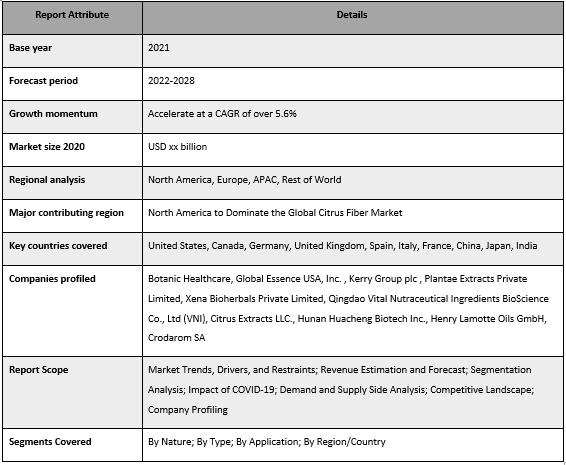
“North America to hold a significant share in the citrus fiber market”
North America is anticipated to be the most alluring regional market, developing at a high CAGR than other regions. North America will continue to be one of the top regions in the worldwide citrus fiber market. Consumers in the U.S. are attracted towards personal care and cosmetics products. They are concerned about the harmful effects of chemicals and synthetic ingredients for personal care and cosmetics products. This will drive the application of citrus fiber across the personal care and cosmetics industry in the U.S. Further, a few of the leading market players operating in North America are Fiberstar Inc.; Florida Food Products, Inc.; etc.
Reasons to buy this report:
- The study includes market sizing and forecasting analysis validated by authenticated key industry experts.
- The report presents a quick review of overall industry performance at one glance.
- The report covers an in-depth analysis of prominent industry peers with a primary focus on key business financials, product portfolio, expansion strategies, and recent developments.
- Detailed examination of drivers, restraints, key trends, and opportunities prevailing in the industry.
- The study comprehensively covers the market across different segments.
- Deep dive regional and country-level analysis of the industry.
Customization Options:
The global citrus fiber market can further be customized as per the requirement or any other market segment. Besides this, UMI understands that you may have your own business needs, hence feel free to connect with us to get a report that completely suits your requirements.
Table of Content
Research Methodology for the Citrus Fiber Market Analysis (2022-2028)
Analyzing the historical market, estimating the current market, and forecasting the future market of the global citrus fiber market were the three major steps undertaken to create and analyze the adoption of citrus fiber in major regions globally. Exhaustive secondary research was conducted to collect the historical market numbers and estimate the current market size. Secondly, to validate these insights, numerous findings and assumptions were taken into consideration. Moreover, exhaustive primary interviews were also conducted, with industry experts across the value chain of the global citrus fiber market. Post assumption and validation of market numbers through primary interviews, we employed a top-down/bottom-up approach to forecasting the complete market size. Thereafter, market breakdown and data triangulation methods were adopted to estimate and analyze the market size of segments and sub-segments of the industry pertains to. Detailed methodology is explained below:
Analysis of Historical Market Size
Step 1: In-Depth Study of Secondary Sources:
Detail secondary study was conducted to obtain the historical market size of the citrus fiber market through company internal sources such as annual reports & financial statements, performance presentations, press releases, etc., and external sources including journals, news & articles, government publications, competitor publications, sector reports, third-party database, and other credible publications.
Step 2: Market Segmentation:
After obtaining the historical market size of the citrus fiber market, we conducted a detailed secondary analysis to gather historical market insights and share for different segments & sub-segments for major regions. Major segments are included in the report as type, nature, and application. Further country-level analyses were conducted to evaluate the overall adoption of testing models in that region.
Step 3: Factor Analysis:
After acquiring the historical market size of different segments and sub-segments, we conducted a detailed factor analysis to estimate the current market size of the citrus fiber market. Further, we conducted factor analysis using dependent and independent variables such as type, nature, and application of citrus fiber. A thorough analysis was conducted for demand and supply-side scenarios considering top partnerships, mergers and acquisitions, business expansion, and product launches in the citrus fiber market across the globe.
Current Market Size Estimate & Forecast
Current Market Sizing: Based on actionable insights from the above 3 steps, we arrived at the current market size, key players in the global citrus fiber market, and market shares of the segments. All the required percentage shares split, and market breakdowns were determined using the above-mentioned secondary approach and were verified through primary interviews.
Estimation & Forecasting: For market estimation and forecast, weights were assigned to different factors including drivers & trends, restraints, and opportunities available for the stakeholders. After analyzing these factors, relevant forecasting techniques i.e., the top-down/bottom-up approach were applied to arrive at the market forecast for 2028 for different segments and sub-segments across the major markets globally. The research methodology adopted to estimate the market size encompasses:
- The industry’s market size, in terms of revenue (USD) and the adoption rate of the citrus fiber across the major markets domestically
- All percentage shares, splits, and breakdowns of market segments and sub-segments
- Key players in the global citrus fiber market in terms of products offered. Also, the growth strategies adopted by these players to compete in the fast-growing market
Market Size and Share Validation
Primary Research: In-depth interviews were conducted with the Key Opinion Leaders (KOLs) including Top Level Executives (CXO/VPs, Sales Head, Marketing Head, Operational Head, Regional Head, Country Head, etc.) across major regions. Primary research findings were then summarized, and statistical analysis was performed to prove the stated hypothesis. Inputs from primary research were consolidated with secondary findings, hence turning information into actionable insights.
Split of Primary Participants in Different Regions
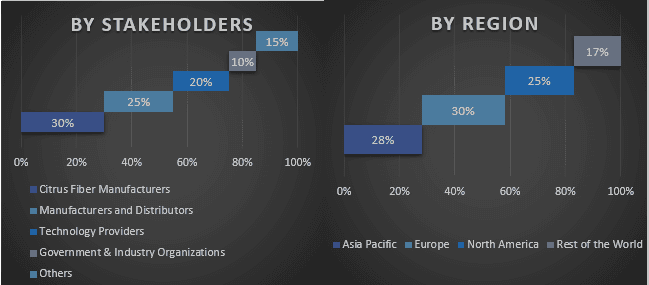
Market Engineering
The data triangulation technique was employed to complete the overall market estimation and to arrive at precise statistical numbers for each segment and sub-segment of the global citrus fiber market. Data was split into several segments & sub-segments post studying various parameters and trends in the areas of the type, nature, and application in the global citrus fiber market.
The main objective of the Global Citrus Fiber Market Study
The current & future market trends of the global citrus fiber market were pinpointed in the study. Investors can gain strategic insights to base their discretion for investments on the qualitative and quantitative analysis performed in the study. Current and future market trends determined the overall attractiveness of the market at a regional level, providing a platform for the industrial participant to exploit the untapped market to benefit from a first-mover advantage. Other quantitative goals of the studies include:
- Analyze the current and forecast market size of the citrus fiber market in terms of value (USD). Also, analyze the current and forecast market size of different segments and sub-segments
- Segments in the study include areas of the type, nature, and application.
- Define and analysis of the regulatory framework for the citrus fiber
- Analyze the value chain involved with the presence of various intermediaries, along with analyzing customer and competitor behaviors of the industry.
- Analyze the current and forecast market size of the citrus fiber market for the major region.
- Major countries of regions studied in the report include Asia Pacific, Europe, North America, and the Rest of the World.
- Company profiles of the citrus fiber market and the growth strategies adopted by the market players to sustain in the fast-growing market
- Deep dive regional level analysis of the industry
Related Reports
Customers who bought this item also bought




